Maximum Of A Quadratic Function
three.2: Quadratic Functions
- Page ID
- 17360
Skills to Develop
- Recognize characteristics of parabolas.
- Sympathize how the graph of a parabola is related to its quadratic part.
- Determine a quadratic role's minimum or maximum value.
- Solve problems involving a quadratic role'due south minimum or maximum value.
Curved antennas, such as the ones shown in Figure \(\PageIndex{1}\), are commonly used to focus microwaves and radio waves to transmit television and phone signals, every bit well every bit satellite and spacecraft communication. The cross-department of the antenna is in the shape of a parabola, which can exist described by a quadratic part.

Figure \(\PageIndex{i}\): An assortment of satellite dishes. (credit: Matthew Colvin de Valle, Flickr)
In this department, nosotros will investigate quadratic functions, which frequently model issues involving area and projectile motion. Working with quadratic functions can be less complex than working with higher degree functions, and then they provide a good opportunity for a detailed written report of function beliefs.
Recognizing Characteristics of Parabolas
The graph of a quadratic function is a U-shaped curve chosen a parabola. 1 important feature of the graph is that information technology has an extreme bespeak, chosen the vertex. If the parabola opens up, the vertex represents the lowest signal on the graph, or the minimum value of the quadratic part. If the parabola opens down, the vertex represents the highest betoken on the graph, or the maximum value. In either case, the vertex is a turning betoken on the graph. The graph is also symmetric with a vertical line drawn through the vertex, called the axis of symmetry. These features are illustrated in Figure \(\PageIndex{2}\).
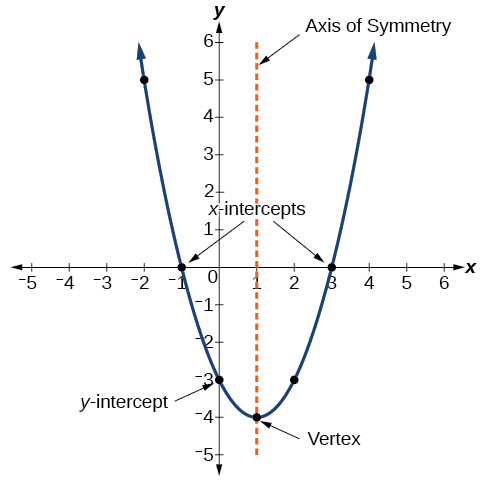
Figure \(\PageIndex{ii}\): Graph of a parabola showing where the \(ten\) and \(y\) intercepts, vertex, and axis of symmetry are.
The \(y\)-intercept is the indicate at which the parabola crosses the \(y\)-centrality. The \(ten\)-intercepts are the points at which the parabola crosses the \(x\)-axis. If they exist, the \(x\)-intercepts represent the zeros, or roots, of the quadratic part, the values of \(x\) at which \(y=0\).
Case \(\PageIndex{1}\): Identifying the Characteristics of a Parabola
Determine the vertex, axis of symmetry, zeros, and \(y\)-intercept of the parabola shown in Figure \(\PageIndex{3}\).

Effigy \(\PageIndex{iii}\).
Solution
The vertex is the turning bespeak of the graph. We can encounter that the vertex is at \((3,i)\). Because this parabola opens upwardly, the centrality of symmetry is the vertical line that intersects the parabola at the vertex. And so the axis of symmetry is \(10=3\). This parabola does not cross the \(10\)-centrality, so information technology has no zeros. Information technology crosses the \(y\)-axis at \((0,7)\) so this is the \(y\)-intercept.
Understanding How the Graphs of Parabolas are Related to Their Quadratic Functions
The general form of a quadratic function presents the function in the grade
\[f(10)=ax^two+bx+c \nonumber\]
where \(a\), \(b\), and \(c\) are existent numbers and \(a \neq 0\). If \(a>0\), the parabola opens upward. If \(a<0\), the parabola opens downward. Nosotros can use the full general grade of a parabola to detect the equation for the axis of symmetry.
The centrality of symmetry is divers by \(x=−\frac{b}{2a}\). If we use the quadratic formula, \(10=\frac{−b{\pm}\sqrt{b^2−4ac}}{2a}\), to solve \(ax^2+bx+c=0\) for the \(10\)-intercepts, or zeros, nosotros discover that the value of \(10\) halfway between them is ever \(x=−\frac{b}{2a}\), the equation for the axis of symmetry.
Figure \(\PageIndex{4}\) represents the graph of the quadratic role written in full general form as \(y=x^2+4x+three\). In this form, \(a=one\), \(b=4\), and \(c=iii\). Because \(a>0\), the parabola opens upward. The axis of symmetry is \(x=−\frac{four}{2(1)}=−two\). This besides makes sense considering we can see from the graph that the vertical line \(10=−ii\) divides the graph in one-half. The vertex always occurs along the axis of symmetry. For a parabola that opens upwardly, the vertex occurs at the lowest point on the graph, in this instance, \((−two,−1)\). The \(x\)-intercepts, those points where the parabola crosses the \(x\)-axis, occur at \((−iii,0)\) and \((−one,0)\).

Figure \(\PageIndex{4}\): Graph of a parabola showing where the \(x\)-intercepts, vertex, and axis of symmetry are for the part \(y=x^2+4x+iii\).
The standard form of a quadratic office presents the function in the form
\[f(10)=a(x−h)^2+thou\nonumber\]
where \((h, g)\) is the vertex. Considering the vertex tin can exist seen in the standard form of the quadratic function, this form is also known as the vertex form of a quadratic function.
As with the general grade, if \(a>0\), the parabola opens upward and the vertex is a minimum. If \(a<0\), the parabola opens downwards, and the vertex is a maximum. Figure \(\PageIndex{v}\) represents the graph of the quadratic function written in standard class as \(y=−3(10+two)^two+iv\). Since \(10–h=x+two\) in this instance, \(h= –2\). In this form, \(a=−iii\), \(h=−2\), and \(m=4\). Considering \(a<0\), the parabola opens downwardly. The vertex is at \((−two, 4)\).

Figure \(\PageIndex{five}\): Graph of a parabola showing where the vertex and axis of symmetry are for the office \(y=-3(ten+two)^2+iv\).
The standard form is useful for determining how the graph is transformed from the graph of \(y=10^two\). Figure \(\PageIndex{half-dozen}\) is the graph of this basic part.
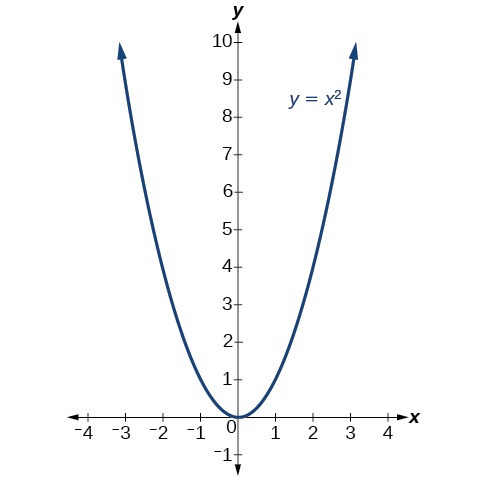
Figure \(\PageIndex{half dozen}\): Graph of \(y=ten^2\).
If \(h>0\), the graph shifts toward the right and if \(h<0\), the graph shifts to the left. In Figure \(\PageIndex{5}\), \(h<0\), so the graph is shifted two units to the left. The magnitude of \(a\) indicates the stretch of the graph. If \(|a|>one\), the point associated with a particular \(10\)-value shifts further from the \(x\)-axis, so the graph appears to get narrower, and in that location is a vertical stretch. But if \(|a|<1\), the point associated with a particular \(10\)-value shifts closer to the \(ten\)-axis. The graph appears to get wider, merely in fact at that place is a vertical pinch. In Effigy \(\PageIndex{five}\), \(|a|>1\), so the graph becomes narrower. Since \(a<0\), the graph is reflected across the \(ten\)-centrality. If \(1000>0\), the graph shifts upwards, whereas if \(one thousand<0\), the graph shifts downward. In Effigy \(\PageIndex{5}\), \(thousand>0\), so the graph is shifted iv units upward.
The standard form and the full general form are equivalent methods of describing the aforementioned part. If we wish to solve for \(h\) and \(one thousand\) in terms of \(a, b,|) and \(x\), nosotros can aggrandize the general form and set it equal to the standard form. In both forms, \(a\) represents the same value.
\[\brainstorm{align*} a(x−h)^ii+one thousand &= ax^2+bx+c \\[5pt] ax^ii−2ahx+(ah^2+chiliad)&=ax^2+bx+c \end{marshal*} \]
For the linear terms to be equal, the coefficients must be equal.
\[–2ah=b \text{, then } h=−\dfrac{b}{2a}. \nonumber\]
This is the axis of symmetry we defined earlier.
Setting the constant terms equal, we go:
\[\begin{marshal*} ah^2+1000&=c \\ k&=c−ah^2 \\ &=c−a\left(\Big(\dfrac{b}{2a}\Big)^2\right) \\ &=c−\dfrac{b^2}{4a}. \end{marshal*}\]
In practice, though, it is unremarkably easier to call up that \(grand\) is the output value of the office when the input is \(h\), and so \(f(h)=k\).
Definitions: Forms of Quadratic Functions
A quadratic function is a function of degree two. The graph of a quadratic role is a parabola.
- The general form of a quadratic part is \(f(x)=ax^2+bx+c\) where \(a\), \(b\), and \(c\) are existent numbers and \(a \neq 0\).
- The standard grade or vertex form of a quadratic role is \(f(x)=a(x−h)^2+yard\).
- The vertex \((h,thousand)\) is located at \[h = -\dfrac{b}{2a},\;k=f(h)=f\left(\dfrac{−b}{2a}\right). \nonumber\]
![]() Write a quadratic part in vertex form, then general form
Write a quadratic part in vertex form, then general form
Given a graph of a quadratic role, write the equation of the function in general course.
- Identify the horizontal shift of the parabola; this value is \(h\). Identify the vertical shift of the parabola; this value is \(m\).
- Substitute the values of the horizontal and vertical shift for \(h\) and \(k\). in the function \(f(10)=a(10–h)^2+chiliad\).
- Substitute the values of any signal, other than the vertex, on the graph of the parabola for \(x\) and \(f(x)\).
- Solve for the coefficient, \(a\).
- If the parabola opens up, \(a>0\). If the parabola opens downward, \(a<0\) since this ways the graph was reflected across the \(x\)-axis.
- Aggrandize and simplify to write in general form.
Example \(\PageIndex{two}\): Writing the Equation of a Quadratic Function from the Graph
Write an equation for the quadratic function \(chiliad\) in Effigy \(\PageIndex{7}\) equally a transformation of \(f(x)=10^2\), and then expand the formula, and simplify terms to write the equation in full general form.
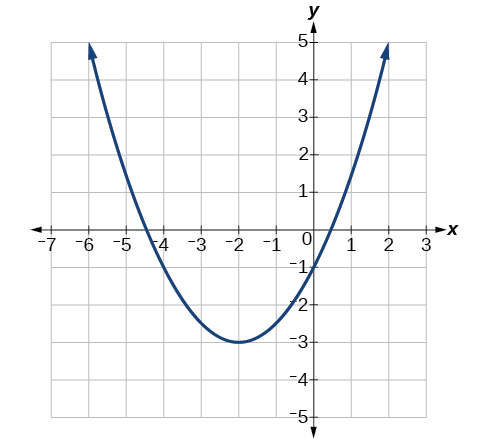
Effigy \(\PageIndex{7}\): Graph of a parabola with its vertex at \((-2, -iii)\).
Solution
Nosotros tin can come across the graph of \(one thousand\) is the graph of \(f(x)=x^2\) shifted to the left 2 and downward 3, giving a formula in the form \(chiliad(10)=a(x+2)^2–3\).
Substituting the coordinates of a point on the curve, such as \((0,−1)\), we can solve for the stretch factor.
\[\begin{align*} −1&=a(0+two)^2−three \\ 2&=4a \\ a&=\frac{1}{2} \end{marshal*}\]
In standard class, the algebraic model for this graph is \(m(x)=\dfrac{1}{2}(ten+ii)^2–iii\).
To write this in full general polynomial form, we can aggrandize the formula and simplify terms.
\[\brainstorm{marshal*} g(x)&=\dfrac{one}{2}(x+two)^ii−3 \\ &=\dfrac{1}{ii}(x+2)(x+2)−3 \\ &=\dfrac{1}{2}(x^2+4x+4)−3 \\ &=\dfrac{i}{ii}x^two+2x+2−3 \\ &=\dfrac{ane}{2}x^2+2x−one \stop{align*}\]
Notice that the horizontal and vertical shifts of the basic graph of the quadratic role determine the location of the vertex of the parabola; the vertex is unaffected by stretches and compressions.
![]() \(\PageIndex{1}\)
\(\PageIndex{1}\)
A coordinate filigree has been superimposed over the quadratic path of a basketball in Effigy \(\PageIndex{8}\). Find an equation for the path of the ball. Does the shooter make the basket?
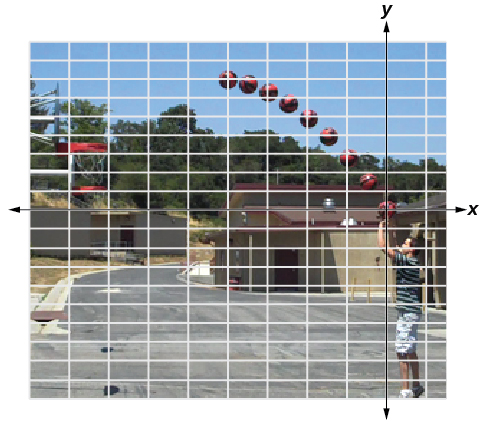
Figure \(\PageIndex{eight}\): Stop motioned picture show of a boy throwing a basketball into a hoop to bear witness the parabolic curve it makes.
(credit: modification of work by Dan Meyer)
- Answer
-
The path passes through the origin and has vertex at \((−4, 7)\), so \(h(x)=–\frac{seven}{16}(10+iv)^two+vii\). To make the shot, \(h(−7.five)\) would need to be about 4 but \(h(–7.5){\approx}1.64\), below the basket; he doesn't make information technology.
![]() Given a quadratic part in general grade, detect the vertex of the parabola.
Given a quadratic part in general grade, detect the vertex of the parabola.
- Place \(a\), \(b\), and \(c\).
- Notice \(h\), the \(10\)-coordinate of the vertex, by substituting \(a\) and \(b\) into \(h=–\frac{b}{2a}\).
- Find \(k\), the \(y\)-coordinate of the vertex, by evaluating \(k=f(h)=f\left(−\frac{b}{2a}\right)\).
Example \(\PageIndex{3}\): Finding the Vertex of a Quadratic Function
Find the vertex of the quadratic function \(f(10)=2x^2–6x+7\). Rewrite the quadratic in standard form (vertex form).
Solution
The horizontal coordinate of the vertex will be at
\[\begin{align*} h&=–\dfrac{b}{2a} \\[5pt] &=-\dfrac{-6}{two(ii)} \\[5pt] &=\dfrac{vi}{4} \\[5pt] &=\dfrac{iii}{2}.\end{align*}\]
The vertical coordinate of the vertex volition be at
\[\begin{align*} one thousand&=f(h) \\[5pt] &=f\left(\dfrac{3}{two}\correct) \\[5pt] &=2\left(\dfrac{3}{2}\right)^2−vi\left(\dfrac{3}{2}\right)+7 \\[5pt] &=\dfrac{5}{2}. \terminate{align*}\]
Rewriting into standard form, the stretch factor will be the same as the \(a\) in the original quadratic:
\[f(x)=ax^2+bx+c \nonumber\\ f(x)=2x^2−6x+7\nonumber\]
Using the \(h\) and \(k\) values of the vertex, rewrite equally
\[f(x)=ii\left(x - \dfrac{3}{ii}\right)^ii+\dfrac{5}{2}. \nonumber\]
Analysis
I reason we may want to identify the vertex of the parabola is that this betoken will inform united states what the maximum or minimum value of the office is \((chiliad)\), and where in the domain it occurs \((h)\).
![]() \(\PageIndex{2}\)
\(\PageIndex{2}\)
Given the equation \(yard(x)=xiii+x^2−6x\), write the equation in general course so in standard form.
- Respond
-
\(thou(x)=ten^2−6x+13\) in full general form; \(g(x)=(x−3)^2+4\) in standard form.
Finding the Domain and Range of a Quadratic Role
Any number tin be the input value of a quadratic part. Therefore, the domain of any quadratic function is all real numbers. Considering parabolas have a maximum or a minimum point, the range is restricted. Since the vertex of a parabola will be either a maximum or a minimum, the range will consist of all \(y\)-values greater than or equal to the \(y\)-coordinate at the turning point or less than or equal to the \(y\)-coordinate at the turning point, depending on whether the parabola opens up or down.
Domain and Range of a Quadratic Function
The domain of any quadratic function is all real numbers.
The range of a quadratic part written in general form \(f(ten)=ax^two+bx+c\) with a positive \(a\) value is \(f(ten) \geq f \left( −\frac{b}{2a}\right)\), or \([ f(−\frac{b}{2a}),∞ ) \) ; the range of a quadratic function written in full general course with a negative \(a\) value is \(f(x) \leq f(−\frac{b}{2a})\), or \((−∞,f(−\frac{b}{2a})]\).
The range of a quadratic function written in standard form \(f(x)=a(x−h)^2+k\) with a positive \(a\) value is \(f(x) \geq 1000;\) the range of a quadratic office written in standard form with a negative \(a\) value is \(f(10) \leq k\).
![]() Given a quadratic function, detect the domain and range.
Given a quadratic function, detect the domain and range.
- Identify the domain of any quadratic role every bit all existent numbers.
- Decide whether \(a\) is positive or negative. If \(a\) is positive, the parabola has a minimum. If \(a\) is negative, the parabola has a maximum.
- Determine the maximum or minimum value of the parabola, \(one thousand\).
- If the parabola has a minimum, the range is given by \(f(x) \geq thou\), or \(\left[one thousand,\infty\right)\). If the parabola has a maximum, the range is given by \(f(ten) \leq 1000\), or \(\left(−\infty,k\right]\).
Example \(\PageIndex{4}\): Finding the Domain and Range of a Quadratic Function
Find the domain and range of \(f(x)=−5x^2+9x−1\).
Solution
Equally with any quadratic office, the domain is all real numbers.
Because \(a\) is negative, the parabola opens downward and has a maximum value. We need to decide the maximum value. We tin can brainstorm by finding the \(10\)-value of the vertex.
\[\begin{marshal*} h&=−\dfrac{b}{2a} \\ &=−\dfrac{ix}{2(-5)} \\ &=\dfrac{9}{10} \end{align*}\]
The maximum value is given by \(f(h)\).
\[\begin{align*} f\left(\dfrac{9}{10}\right)&=-five(\dfrac{ix}{10})^2+nine(\dfrac{9}{x})-1 \\&= \dfrac{61}{xx}\end{align*}\]
The range is \(f(x) \leq \frac{61}{xx}\), or \(\left(−\infty,\frac{61}{twenty}\correct]\).
![]() \(\PageIndex{3}\)
\(\PageIndex{3}\)
Find the domain and range of \(f(x)=ii\left(x−\frac{4}{7}\right)^2+\frac{8}{11}\).
- Reply
-
The domain is all real numbers. The range is \(f(ten) \geq \frac{8}{eleven}\), or \(\left[\frac{8}{11},\infty\right)\).
Determining the Maximum and Minimum Values of Quadratic Functions
The output of the quadratic office at the vertex is the maximum or minimum value of the role, depending on the orientation of the parabola. We tin see the maximum and minimum values in Effigy \(\PageIndex{9}\).

Effigy \(\PageIndex{9}\): Minimum and maximum of 2 quadratic functions.
In that location are many real-earth scenarios that involve finding the maximum or minimum value of a quadratic role, such as applications involving area and revenue.
Case \(\PageIndex{5}\): Finding the Maximum Value of a Quadratic Function
A backyard farmer wants to enclose a rectangular space for a new garden inside her fenced backyard. She has purchased lxxx feet of wire fencing to enclose three sides, and she will utilize a section of the backyard argue as the fourth side.
- Observe a formula for the expanse enclosed by the fence if the sides of fencing perpendicular to the existing fence have length \(L\).
- What dimensions should she make her garden to maximize the enclosed area?
Solution
Let's use a diagram such as Effigy \(\PageIndex{10}\) to record the given information. Information technology is also helpful to introduce a temporary variable, \(W\), to represent the width of the garden and the length of the fence section parallel to the backyard contend.
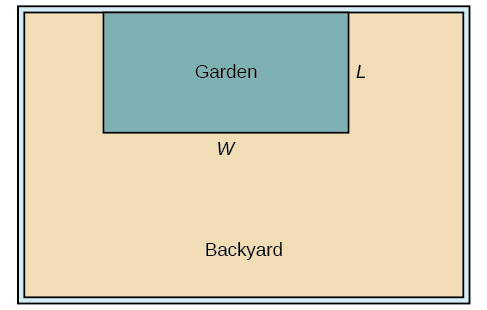
Figure \(\PageIndex{10}\): Diagram of the garden and the backyard.
a. We know nosotros take only eighty feet of fence available, and \(L+Westward+L=80\), or more simply, \(2L+Westward=80\). This allows us to represent the width \(W\) in terms of \(L\).
\[W=80−2L \nonumber\]
Now we are ready to write an equation for the area the contend encloses. We know the area of a rectangle is length multiplied by width, so
\[\begin{align*} A&=LW=L(80−2L) \\ A(L)&=80L−2L^2 \end{align*}\]
This formula represents the area of the contend in terms of the variable length \(L\). The function, written in general form, is
\[A(50)=−2L^2+80L \nonumber\].
b. The quadratic has a negative leading coefficient, so the graph will open downward, and the vertex will be the maximum value for the surface area. In finding the vertex, we must be careful because the equation is non written in standard polynomial form with decreasing powers. This is why nosotros rewrote the function in general form above. Since \(a\) is the coefficient of the squared term, \(a=−2\), \(b=fourscore\), and \(c=0\).
To find the vertex:
\[\begin{align*} h& =−\dfrac{eighty}{ii(−2)} \qquad\text{ and }&k&=A(20) \\ &=20 & \;\;\;\;\quad &=80(20)−2(20)^ii \\ &&&=800 \end{marshal*}\]
The maximum value of the function is an surface area of 800 square feet, which occurs when \(L=twenty\) feet. When the shorter sides are 20 feet, in that location is 40 feet of fencing left for the longer side. To maximize the area, she should enclose the garden so the two shorter sides take length 20 feet and the longer side parallel to the existing fence has length 40 anxiety.
Analysis
This problem also could be solved by graphing the quadratic function. We tin come across where the maximum area occurs on a graph of the quadratic function in Figure \(\PageIndex{11}\).
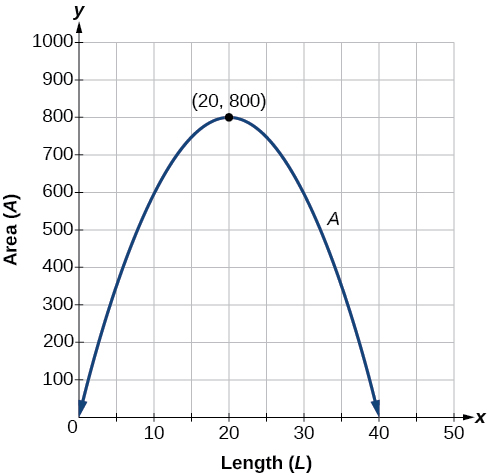
Figure \(\PageIndex{11}\): Graph of the parabolic function \(A(L)=-2L^2+80L\)
![]() Given an application involving acquirement, use a quadratic equation to find the maximum
Given an application involving acquirement, use a quadratic equation to find the maximum
- Write a quadratic equation for acquirement.
- Notice the vertex of the quadratic equation.
- Determine the \(y\)-value of the vertex.
Example \(\PageIndex{half-dozen}\): Finding Maximum Revenue
The unit of measurement toll of an item affects its supply and demand. That is, if the unit of measurement cost goes up, the demand for the item will usually decrease. For example, a local newspaper currently has 84,000 subscribers at a quarterly accuse of $30. Market research has suggested that if the owners raise the price to $32, they would lose 5,000 subscribers. Assuming that subscriptions are linearly related to the price, what price should the newspaper accuse for a quarterly subscription to maximize their revenue?
Solution
Acquirement is the amount of coin a company brings in. In this case, the revenue can exist establish by multiplying the price per subscription times the number of subscribers, or quantity. We tin can introduce variables, \(p\) for price per subscription and \(Q\) for quantity, giving u.s. the equation \(\text{Acquirement}=pQ\).
Because the number of subscribers changes with the price, we need to find a relationship betwixt the variables. We know that currently \(p=thirty\) and \(Q=84,000\). We also know that if the toll rises to $32, the newspaper would lose 5,000 subscribers, giving a second pair of values, \(p=32\) and \(Q=79\mbox{,}000\). From this we can find a linear equation relating the two quantities. The slope will be
\[\brainstorm{align*} m&=\dfrac{79,000−84,000}{32−30} \\ &=−\dfrac{five,000}{ii} \\ &=−2,500 \finish{align*}\]
This tells united states of america the paper volition lose ii,500 subscribers for each dollar they raise the cost. Nosotros tin can then solve for the \(y\)-intercept.
\[\begin{align*} Q&=−2500p+b &\text{Substitute in the point $Q=84,000$ and $p=30$} \\ 84,000&=−2500(30)+b &\text{Solve for $b$} \\ b&=159,000 \end{align*}\]
This gives u.s.a. the linear equation \(Q=−ii,500p+159,000\) relating cost and subscribers. We at present return to our revenue equation.
\[\begin{align*} \text{Revenue}&=pQ \\ \text{Revenue}&=p(−2,500p+159,000) \\ \text{Revenue}&=−2,500p^2+159,000p \cease{align*}\]
Nosotros accept a quadratic function for revenue as a function of the subscription charge. To find the price that will maximize revenue for the newspaper, we can detect the vertex.
\[\brainstorm{align*} h&=−\dfrac{159,000}{2(−2,500)} \\ &=31.8 \end{align*}\]
The model tells us that the maximum acquirement will occur if the newspaper charges $31.80 for a subscription. To find what the maximum revenue is, we evaluate the revenue function.
\[\begin{marshal*} \text{maximum acquirement}&=−2,500(31.8)^2+159,000(31.8) \\ &=2,528,100 \end{align*}\]
Assay
This could besides be solved by graphing the quadratic every bit in Effigy \(\PageIndex{12}\). We can run into the maximum revenue on a graph of the quadratic function.

Figure \(\PageIndex{12}\): Graph of the parabolic function
Finding the \(x\)- and \(y\)-Intercepts of a Quadratic Part
Equally a tool to help usa graph parabolas, we need to find intercepts of quadratic equations. Call up that we detect the \(y\)-intercept of a quadratic by evaluating the function at an input of zero, and nosotros find the x-intercepts at locations where the output is nil. Notice in Effigy \(\PageIndex{xiii}\) that the number of \(10\)-intercepts can vary depending upon the location of the graph.

Figure \(\PageIndex{13}\): Number of x-intercepts of a parabola.
![]() Given a quadratic part \(f(x)\), find the \(y\)- and \(10\)-intercepts
Given a quadratic part \(f(x)\), find the \(y\)- and \(10\)-intercepts
- Evaluate \(f(0)\) to find the \(y\)-intercept.
- Solve the quadratic equation \(f(x)=0\) to detect the \(ten\)-intercepts.
Example \(\PageIndex{7}\): Finding the \(y\)- and \(10\)-Intercepts of a Parabola
Find the \(y\)- and \(x\)-intercepts of the quadratic \(f(x)=3x^2+5x−2\).
Solution
We detect the \(y\)-intercept past evaluating \(f(0)\).
\[\begin{align*} f(0)&=3(0)^two+5(0)−2 \\ &=−2 \terminate{align*}\]
The \(y\)-intercept is at \((0,−2)\).
For the \(10\)-intercepts, we find all solutions of \(f(x)=0\).
\[0=3x^2+5x−two\nonumber\]
In this case, the quadratic can be factored, providing the simplest method for solution.
\[0=(3x−1)(x+two)\nonumber\]
\[\begin{align*} 0&=3x−i & 0&=ten+two \\ x&= \frac{ane}{3} &\text{or} \;\;\;\;\;\;\;\; 10&=−2 \end{align*}\]
The \(x\)-intercepts are at \((\frac{1}{3},0)\) and \((−ii,0)\).
Analysis
By graphing the office, we can confirm that the graph crosses the \(y\)-centrality at \((0,−2)\). Nosotros tin as well ostend that the graph crosses the \(x\)-centrality at \(\Big(\frac{one}{three},0\Big)\) and \((−2,0)\). Meet Figure \(\PageIndex{14}\).
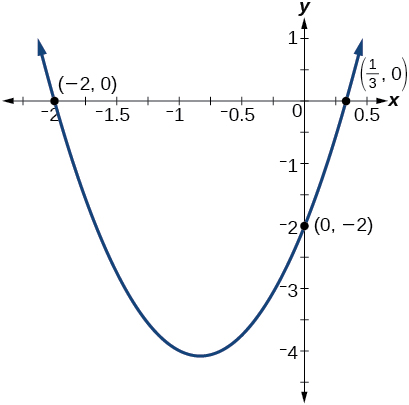
Figure \(\PageIndex{14}\): Graph of a parabola.
Rewriting Quadratics in Standard Form
In Instance \(\PageIndex{7}\), the quadratic equation was fairly easily solved by factoring. However, there are many quadratics that cannot be factored using rational numbers. Another method for solving quadratic equations is past kickoff rewriting the quadratic in standard form. This method is also known equally solving by completing the square.
![]() Given a quadratic role, observe the \(x\)-intercepts by rewriting in standard class.
Given a quadratic role, observe the \(x\)-intercepts by rewriting in standard class.
- Substitute \(a\) and \(b\) into \(h=−\frac{b}{2a}\).
- Substitute \(x=h\) into the general grade of the quadratic function to find \(k\).
- Rewrite the quadratic in standard form using \(h\) and \(k\).
- Solve for when the output of the function will be zero to discover the \(x\)-intercepts.
Example \(\PageIndex{8}\): Finding the \(10\)-Intercepts of a Parabola
Find the \(x\)-intercepts of the quadratic function \(f(x)=2x^2+4x−4\).
Solution
We need to solve for when the output will be zilch:
\[0=2x^2+4x−iv. \nonumber\]
Because the quadratic is non easily factorable in this case, we solve for the intercepts by outset rewriting the quadratic in standard form.
\[f(x)=a(10−h)^2+g\nonumber\]
We know that \(a=2\). So we solve for \(h\) and \(k\).
\[\begin{align*} h&=−\dfrac{b}{2a} & k&=f(−1) \\ &=−\dfrac{4}{2(2)} & &=two(−one)^2+4(−ane)−4 \\ &=−1 & &=−6 \stop{align*}\]
At present nosotros tin can rewrite in standard class.
\[f(ten)=2(10+ane)^ii−vi\nonumber\]
Nosotros are ready to solve for when the output will be zero.
\[\brainstorm{align*} 0&=2(x+one)^two−vi \\ 6&=two(10+i)^2 \\ 3&=(ten+1)^two \\ x+one&={\pm}\sqrt{iii} \\ x&=−1{\pm}\sqrt{3} \approx 0.73 \mbox{ or } -2.73 \finish{marshal*}\]
The graph has \(x\)-intercepts at \((−1−\sqrt{3},0)\) and \((−ane+\sqrt{iii},0)\). Note that the \(ten\)-values are irrational numbers.
Analysis
We can check our work by graphing the given office on a graphing utility and observing an approximation of the \(ten\)-intercepts. See Effigy \(\PageIndex{15}\).
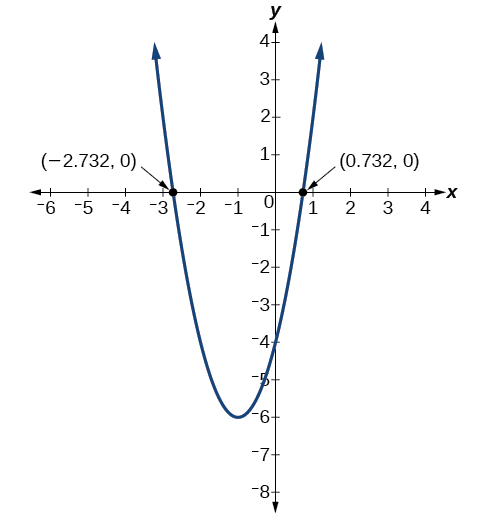
Effigy \(\PageIndex{15}\): Graph of a parabola which has the following x-intercepts: \((-2.73, 0)\) and \((0.73, 0)\).
![]() \(\PageIndex{4}\)
\(\PageIndex{4}\)
In ![]() \(\PageIndex{2}\), we found the standard and general form for the function \(g(ten)=13+ten^2−6x\). Now find the \(y\)- and \(ten\)-intercepts (if any).
\(\PageIndex{2}\), we found the standard and general form for the function \(g(ten)=13+ten^2−6x\). Now find the \(y\)- and \(ten\)-intercepts (if any).
- Answer
-
\(y\)-intercept at \((0, 13)\), no \(x\)-intercepts
Case \(\PageIndex{nine}\): Solving a Quadratic Equation with the Quadratic Formula
Find the zeros of \(f(10)=x^two +ten +2\). We set up \(f(x)=0\), and solve: \(x^2+x+two=0\).
Solution
Let's begin by writing the quadratic formula: \(ten=\frac{−b{\pm}\sqrt{b^2−4ac}}{2a}\).
When applying the quadratic formula, we identify the coefficients \(a\), \(b\) and \(c\). For the equation \(x^2+x+2=0\), nosotros have \(a=ane\), \(b=1\), and \(c=two\). Substituting these values into the formula we take:
\[\brainstorm{align*} ten&=\dfrac{−b{\pm}\sqrt{b^2−4ac}}{2a} \\ &=\dfrac{−i{\pm}\sqrt{one^two−4⋅1⋅(2)}}{2⋅i} \\ &=\dfrac{−i{\pm}\sqrt{1−8}}{2} \\ &=\dfrac{−1{\pm}\sqrt{−7}}{2} \\ &=\dfrac{−1{\pm}i\sqrt{7}}{2} \end{marshal*}\]
The solutions to the equation are \(x=\frac{−one+i\sqrt{7}}{ii}\) and \(x=\frac{−1-i\sqrt{seven}}{two}\) or \(10=−\frac{1}{2}+\frac{i\sqrt{7}}{2}\) and \(ten=\frac{-i}{2}−\frac{i\sqrt{7}}{2}\). Since at that place are no real-valued solutions to the equation, there are no real zeros. The graph of this parabola will not cross the \(ten\)-centrality.
Instance \(\PageIndex{10}\): Applying the Vertex and 10-Intercepts of a Parabola
A brawl is thrown upward from the superlative of a 40 foot high building at a speed of fourscore feet per second. The ball's pinnacle above ground can be modeled by the equation \(H(t)=−16t^2+80t+40\).
When does the brawl reach the maximum top?
What is the maximum peak of the ball?
When does the ball hit the ground?
The ball reaches the maximum elevation at the vertex of the parabola.
\[\begin{marshal*} h &= −\dfrac{80}{2(−16)} \\ &=\dfrac{fourscore}{32} \\ &=\dfrac{5}{ii} \\ & =two.5 \end{align*}\]
The ball reaches a maximum height after 2.5 seconds.
To discover the maximum superlative, notice the \(y\)-coordinate of the vertex of the parabola.
\[\begin{align*} k &=H(−\dfrac{b}{2a}) \\ &=H(two.5) \\ &=−16(2.5)^2+80(2.five)+40 \\ &=140 \end{marshal*}\]
The brawl reaches a maximum tiptop of 140 feet.
To find when the ball hits the ground, we need to make up one's mind when the pinnacle is zip, \(H(t)=0\).
Nosotros use the quadratic formula.
\[\brainstorm{align*} t & =\dfrac{−80±\sqrt{80^2−4(−16)(forty)}}{two(−16)} \\ & = \dfrac{−80±\sqrt{8960}}{−32} \cease{align*} \]
Because the square root does not simplify nicely, nosotros can use a reckoner to approximate the values of the solutions.
\[t=\dfrac{−80-\sqrt{8960}}{−32} ≈five.458 \text{ or }t=\dfrac{−80+\sqrt{8960}}{−32} ≈−0.458 \]
The second answer is outside the reasonable domain of our model, and so we conclude the ball volition hit the footing afterwards about 5.458 seconds. Meet Figure \(\PageIndex{xvi}\).
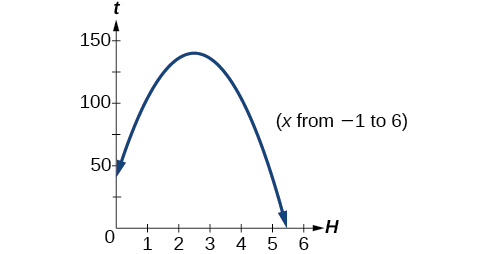
Effigy \(\PageIndex{16}\)
![]() \(\PageIndex{five}\)
\(\PageIndex{five}\)
A rock is thrown upwardly from the meridian of a 112-foot high cliff overlooking the ocean at a speed of 96 feet per second. The stone's height above ocean can exist modeled by the equation \(H(t)=−16t^2+96t+112\).
- When does the stone accomplish the maximum tiptop?
- What is the maximum acme of the rock?
- When does the stone hitting the ocean?
- Respond
-
a. 3 seconds
b. 256 feet
c. 7 seconds
Cardinal Equations
- full general course of a quadratic function: \(f(10)=ax^two+bx+c\)
- the quadratic formula: \(10=\dfrac{−b{\pm}\sqrt{b^2−4ac}}{2a}\)
- standard, or vertex, form of a quadratic part: \(f(10)=a(ten−h)^2+g\)
Central Concepts
- A polynomial part of degree ii is called a quadratic part.
- The graph of a quadratic part is a parabola. A parabola is a U-shaped curve that tin open either upward or downwardly.
- The axis of symmetry is the vertical line passing through the vertex. The zeros, or \(x\)-intercepts, are the points at which the parabola crosses the \(x\)-axis. The \(y\)-intercept is the point at which the parabola crosses the \(y\)-centrality.
- Quadratic functions are oftentimes written in general form. Standard or vertex form is useful to easily identify the vertex of a parabola. Either grade can be written from a graph.
- The vertex can be found from either the general form or the standard form of a quadratic part.
- The domain of a quadratic office is all real numbers. The range varies with the function.
- A quadratic role'due south minimum or maximum value is given by the \(y\)-value of the vertex.
- The minimum or maximum value of a quadratic function can be used to determine the range of the function and to solve many kinds of real-world bug, including bug involving expanse and acquirement.
- Some quadratic equations must be solved by using the quadratic formula, or by completing the square.
- The vertex and the intercepts tin be identified and interpreted to solve real-world problems.
Glossary
axis of symmetry
a vertical line drawn through the vertex of a parabola effectually which the parabola is symmetric; defined past \(x=−\frac{b}{2a}\)
general class of a quadratic function
the function that describes a parabola, written in the form \(f(x)=ax^two+bx+c\), where \(a,b,\) and \(c\) are existent numbers and \(a≠0\)
standard form of a quadratic function
the function that describes a parabola, written in the course \(f(ten)=a(ten−h)^2+g\), where \((h, k)\) is the vertex
vertex
the point at which a parabola changes direction, corresponding to the minimum or maximum value of the quadratic function
vertex grade of a quadratic function
another name for the standard grade of a quadratic office
zeros
in a given function, the values of \(x\) at which \(y=0\), also chosen roots
Maximum Of A Quadratic Function,
Source: https://math.libretexts.org/Courses/Borough_of_Manhattan_Community_College/MAT_206_Precalculus/3:_Polynomial_and_Rational_Functions_New/3.2:_Quadratic_Functions
Posted by: mitchellmovence.blogspot.com


0 Response to "Maximum Of A Quadratic Function"
Post a Comment